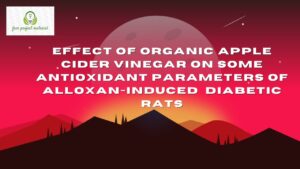ABSTRACT
Studies conducted on the effect of storage materials and fermentation time on vitamin A and C content of palm oil the storage material were bottles, rubber and calabash. While the fermentation time was 0 hour, 24 hours and 48 hours. At the end of the research it was observed from the result that the fresh palm wine that undergo fermentation at 12.53 mg/100g of vitamin of vitamin A in the container and 6.22 mg/100g of vitamin C in all the containers as well. They were significant reduction of vit A in the difference containers as fermentation time rose to 48 hours. The result however shows that vitamin C content increased in calabash with fermentation time but decrease in bottle and rubber as the fermentation time was prolong for 48 hours. The implication of this research is that the longer palm wine is kept to ferment, the more vitamin A will reduce respective of whether the wine is stored in bottle, rubber or calabash. It also implies that calabash seem to best storage material for palm wine best on its ability to retain the vitamin C content for as long as 48 hours.
TABLE OF CONTENTS
Title Page – – – – – – – – – i
Certification – – – – – – – – – ii
Dedication – – – – – – – – – iii
Acknowledgement – – – – – – – – iv
Abstract – – – – – – – – – vi
Table of Contents – – – – – – – – vii
CHAPTER ONE: INTRODUCTION
1.1 Background of the study – – – – – – 1
1.2 Aim and Objectives of the study – – – – 3
1.2.1 Aim – – – – – – – – – 3
1.2.2 Objectives – – – – – – – – 3
1.3 Scope and Limitation of the study – – – – 4
1.4 Significance of the Study – – – – – – 4
1.4 Definition of terms – – – – – – – 4
CHAPTER TWO: REVIEW OF RELATED LITERATURE
2.1 Palm Wine – – – – – – – – 6
2.1.1 Sources and Production of Palm Wine – – – – 6
2.1.2 Chemical Composition of Palm Wine – – – – 7
2.1.3 Uses of Palm Wine – – – – – – 8
2.2 Vitamins – – – – – – – – 9
2.3 Concept of Fermentation Process – – – – 12
2.3.1 Fermentation Products of Palm Wine – – – – 13
2.3.2 Factors which affect Fermentation – – – – 15
2.3.3 Biological Importance of Fermentation – – – 19
2.4 Vitamins – – – – – – – – 20
2.4.1 Vitamin A and its Importance – – – – – 20
2.4.2 Source of Vitamin A and Importance – – – – 22
2.4.3 Vitamin C: Sources and Importance – – – – 24
2.4.4 Deficiency Effects of Vitamin C – – – – 28
2.4.5 Deficiency Effects of Vitamin A – – – – 29
CHAPTER THRE: MATERIALS AND METHOD
3.1 Materials – – – – – – – – 30
3.2 Collection of Samples/preparation before Analysis – – 31
3.2.1 Collection Sample/Preparation before Analysis – – 31
3.3 Determination of Vitamin A and C – – – – 32
3.3.1 Procedure for Determination of Vitamin A – – – 32
3.3.2 Procedure for Determination of Vitamin C – – – 33
CHAPTER FOUR: RESULTS AND DISCUSSION
4.1 Results – – – – – – – – 35
4.2 Discussion – – – – – – – – 36
CHAPTER FIVE: CONCLUSION AND RECOMMENDATIONS
5.1 Conclusion – – – – – – – – 39
5.2 Recommendations – – – – – – – 40
Reference
CHAPTER ONE: INTRODUCTION
1.1 Background of the study
Palm wine is an alcoholic beverage obtained from the sap of various palm trees. Pal wine; whitish liquid with a distinct flavor and is often use in traditional ceremonies. Thus, it has a very wide consumption rate because of its good nutritional and medicinal values as it contains vitamins, protein and other useful components. (Ayogu,1999).
There is various storage materials used in storing palm wine. Bassir, (1982) reported that these materials may undergo some reactions with some components of the material thereby reducing the quality of the palm wine, one of such component is vitamin contents. The vitamins in the palm wine seem to be one of the major contributors to its nutritional value.
Vitamins are group of organic nutrients required in small quantities for various biochemical functions. Generally, vitamins cannot be synthesized by the body and must therefore be supplied in the diet. Although vitamins do not provide energy or make up our cells organs, the body cannot carryout many of the biochemical process without vitamins (Fatemi et al., 1991).
Vitamins are derived from foods and are essential to keep the body healthy and make the mind alert (Brittron et al., 1994).
It is well known fact that during storage of palm wine certain processes occur one of such processes is fermentation. Fermentation is affected by type of storage material and the length of time the sample is kept. Vitamins are derived from foods are essential to keep the body healthy and makes the mind alert (Brittron, et al., 1994).
Researches have shown that vitamins interact with other nutrients in processes such as metabolism, digestion and developing blood cells (Greenes, 2003). Some vitamins are said to slow down the ageing process, prevent cancerous cells attacking the body and strengthens the immune system (bender, 2003). A lack of certain Vitamins can lead to fatigue, poor skin, teeth and bones and in some cases of several deficiencies it can result in serious illness and death (Woods and Fletcher, 1992). It is well known that during storage of palm wine certain process occur. One of such process is fermentation. Fermentation is affect by tte type of storage material and the length of time the sample is kept. This research therefore intends to determine whether different storage materials of palm wine affect the vitamins contents or not. It also hopes to evaluate the fermentation time on the vitamin content. It is the hope of the researcher that this research will determine the best storage material for palm wine and the fermentation time which will not interfere with vitamin A and C in palm wine.
1.2 Aim and objectives of the Study
1.2.1 Aim:
The aim of this research work is to determine the effect of fermentation time and storage material on the vitamin A and C contents of palm wine.
1.2.2 Objectives:
- To determine vitamins A and C content in fresh palm wine.
- To determine vitamins A and C content in palm wine that has been kept overnight.
iii. To determine vitamin A and C content in palm wine that has been stored in calabash bottle and plastic containers for 24 hours.
- To compare the results obtained for different experimental processes.
- To discuss the implication of the result.
- To make recommendations based on the results.
1.3 Scope and Limitation of the Study
This research work focuses on the effect of different storage materials and fermentation time on vitamins content of palm wine. The research work is limited to two different vitamins (A and C) and three different storage materials i.e. wooden calabash, bottle and plastic. Due to time and financial constraints, this research could not go beyond this scope.
1.4 Significance of the Study
This research will be of immense benefits to consumers of palm wine, marketers and brewers. It will add value and knowledge to available literature in the relevant area.
1.5 Definitions of Terms
The following terms are defined in relation to the topic of the research:
Palm Wine: This is an alcoholic beverage produced by natural fermentation of sap of various palms; which include Elies guineensis, Raphia regalis, R. suddnica and vinifera.
Vitamins: these are organic compounds that are required in the diet in small amounts for the maintenance of normal metabolic functions.
Storage: This is the act of preserving solid, gaseous or liquid foods for future use.
Storage Materials: These are different materials like plastic, bottle, wooden calabash and ceramics in which substances can be stored and preserved for future use.
Sap: This is a fresh cloudy fluid, chiefly water with dissolved sugars and mineral salts circulating in the vascular system of a plant.
Tapping: This is a process that is involved in drawing sap from a palm tree by cutting into it and then connecting into the receiver.
Fermentation: is a metabolic process that produces chemical changed in organic substances through the action of enzymes.



